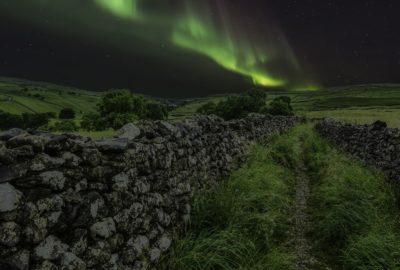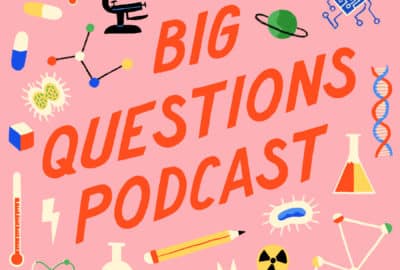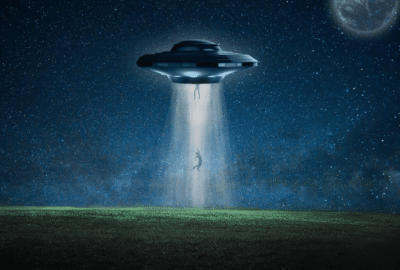Why is the James Webb Space Telescope a big deal?
Wednesday 15th Jun 2022, 12.30pm
Are we alone in the Universe? What exactly lies at the centre of our galaxy? Just like our podcast, the James Webb Space Telescope aims to answer some *very big questions*. Launched on Christmas Day 2021 and hurtling towards an orbit 1.5 million miles from the Earth, the JWST (as it’s known to those in the business!) is a follow-up to the Hubble Space Telescope – and it’s three times bigger. Decades in the making, the JWST will begin collecting and transmitting scientific data in July 2022, making this a really exciting time for astrophysicists such as Dr Becky Smethurst. We catch up with her to find out more.
(Music)
Emily Elias: Astronomy lovers are getting really excited. The first images and data from the deepest parts of space are about to be released and they will possibly answer and possibly create even more questions.
On this episode of the Oxford Sparks Big Questions podcast, we are asking, why is the James Webb Space Telescope a big deal?
(Music)
Hello, I’m Emily Elias. And this is the show where we seek out the brightest minds at the University of Oxford. And we ask them the big questions. And for this one, we have reached our personal guide to the galaxies.
Becky Smethurst: My name is Dr Becky Smethurst and I am an astrophysicist at the University of Oxford. My research is all about super, massive black holes and how they grow.
Emily: That sounds like a new song-
Becky: (Laughter) Yeah, it is. It’s my like permanent personal soundtrack.
Emily: Okay. So the James Webb Space Telescope, I’ve never heard of this before. I apologise, please help me understand what is it?
Becky: So the James Webb Space Telescope, or JWST as we call it in the astrophysics cool crowd is the, sort of, follow up to the Hubble space telescope. The Hubble space telescope has been in space for 30 years or so, providing us with all those incredible images of nebular and galaxies that we like to look at and marvel at because they’re such pretty colours. And the James Webb Space Telescope is essentially the next big space telescope that we’ve put up there. It is three times bigger than Hubble.
So it has a mirror that is 6.5 meters wide to collect light as it looks into space. Whereas Hubble’s was only 2.5 meters. So it’s much bigger than Hubble and it actually looks at a different type of light than the Hubble space telescope does. It looks in the infrared light rather than visible light that we actually see with our eyes.
And that’s been done on purpose. You can actually resolve smaller things on the sky. So further away things, the longer the wavelength of light that you look in infrared, longer than red wavelengths, that’s what that means; so longer wavelengths means we can look at smaller things, which is great. We can see more detail.
But also we can see the light from further away things as well. Because the universe is expanding, light gets stretched on its way to us. So light that left objects 13 billion years ago in the very early days of the solar system, it might have left a galaxy or a star as optical, visible light that we could see with our eyes or with the Hubble space telescope, but by the time that it’s reached us after traveling for 13 billion years, it’s been stretched so much that you can’t actually see it in visible wavelengths anymore.
You have to look in the infrared to be able to spot these things. And so that’s what James Webb has been designed to do, to spot the really far away, really small things in the infrared, but then the bonus is that also in the infrared, you can look for other cool things, like, water that’s present in exoplanet atmospheres.
So it’s a really, really cool space telescope. And it’s one that is probably going to revolutionise so many areas of astronomy and astrophysics and help us to answer so many questions that have been, you know, burning questions for so long that we’ve had that we’ve not been able to get the data that we need to answer.
And so James Webb, it was launched on Christmas Day, last year, 2021, which was a nerve-wracking Christmas Day, let me tell you, because there’s always something that could go wrong with a rocket launch, but thankfully it was better than expected. And since then the James Webb Space Telescope has been traveling to where it’s going to spend the rest of its life, which is about 1.5 million kilometres further away from earth, away from the direction of the sun.
And it’s going to orbit the sun from there. And since then, they’ve been doing a lot of commissioning as well, checking everything is working okay, that everything’s aligned properly and that it’s working as expected before they’re going to start taking science data in July, 2022.
So it’s very, very soon that this data is coming and this is why all of us in the astrophysics community are so excited for this, because this is a project that’s been decades in the making, and we’re finally going to start seeing some science data from this thing very, very soon.
Emily: I can tell you’re buzzing. I mean, let’s dig into some of these mysteries of the universe that it could answer, because you’ve helped outline some of them, but I mean, it feels like a different language, so help me translate this. Okay. TRAPPIST-1. What the heck is that?
Becky: TRAPPIST-1 is possibly my favourite planet system after the solar system, I guess. So we’ve only just in recent years, been starting to find planets that orbit other stars in our Milky Way galaxy. So not planets orbiting the sun, but any other star in the galaxy, we started finding them and finding them – great. We know that they’re there.
The next step is characterising them. And TRAPPIST-1 is a really cool system because there’s seven planets in it. So it’s very similar to the solar system, except for the fact that the star is a lot smaller than the sun. It’s a lot cooler than the sun and the planets orbit a lot closer in, so there’s the four inner planets in the system actually could fit inside the orbit of mercury, in our own solar system if you were to plonk it in the middle as well.
But because the star is so much cooler that still puts them in what we call the habitable zone of this planetary system where it’d be not too hot and not too cold for life to exist. And so one of the things we want to do with the James Webb Space Telescope is try and isolate the tiny bit of the star light that passes through these planets’ atmospheres on its way to us.
And so find the missing bits of light that are missing because they’ve been absorbed by water or carbon dioxide or methane or ozone in the atmosphere of these planets. The kind of, you know, molecules that we associate with life, as we know it on this planet, at least, right? So that’s what been incredibly exciting, finding in this system that’s very similar to the solar system, that has planets that are in this Goldilocks habitable zone, where it’s not too hot, not too cold for life and finding also signatures of water. That water is present in that atmosphere. That’s like having all of the ingredients out of the cupboard and the oven turned on, right, in terms of cooking up life?
And one of the things that James Webb is going to be able to do, is ask that question of, it’ll at least get closer to answering the question of, are we alone in the universe?
Emily: Ah, real X-File stuff. Okay. So the next one that you wanted to point out, the mysteries it could answer, honestly, looks like gibberish to me. GN-z11 and HD-12. I don’t even how to Google that and nothing would come up. What is this?
Becky: Essentially, what it’s saying is that we found a galaxy that it is a red shift of 11, so GN-z11. And what do we mean by a red shift of 11? Is that in terms of, okay, what wavelength is the light now that we detect compared to what was the wavelength of light when it was emitted; it’s changed by a ratio of 11.
And so from that number, we can then work out, “Okay. Well, how long has the light been traveling through the universe? Therefore, how distant is this galaxy?” And therefore these two candidates are GN-z11 and HD-12. They are some of the most distant galaxies known or at least we think we know.
They’re what we call candidate distant galaxies. Our best guess is that they’re at those distances because they’re guessed from the fact that they disappear in data from the Hubble space telescope. We see them at one wavelength and then all of a sudden they’re missing at the other wavelength because it’s dropped out because that visible wavelength has been red-shifted so much.
But with James Webb, it actually detects the infrared light that we can get from these galaxies. And we can actually get at a much more accurate distance for these things. And so I think there’s a big debate raging over whether GN-z11 is further away or is HT-12 further away? And James Webb will probably settle that debate and tell us for definite which one, but also it’s probably going to find way, way more galaxies that are even further away than that.
And the debate will probably just fizzle out into the background cause it won’t matter anymore. And that’s, I think what’s so special about James Webb is that we’re going to see things that see beyond what we call our, sort of, horizon of visibility at the minute. We can only see the observable universe.
So the parts of the universe where light has had time to actually travel to us. Travelling at the speed of light and James Webb is literally going to be able to push to those very edges by seeing an infrared light.
Emily: Basically, we are upgrading from 30 year old technology that’s been floating in space to the best that we can muster and finally figure out if these are in fact the most distant galaxies known to us?
Becky: Exactly. Yeah, yeah, exactly that. And I mean, it’s incredible, the technology that’s gone into this thing. One of the things that always blows my mind is that the mirrors, for example, that make up this telescope, so it’s one big hexagon, 6.5 meters across, but it’s made of little segments. And these segments when they were made in the lab were made at the wrong shape, knowing that when they were launched into space where it’s incredibly cold, they would deform to a different shape, which would then be the right one for it to be nice and flat for it to work as a telescope.
You know, it blows my mind that we can like reverse engineer it like that. But also they’ve got these tiny little, sort of, motors behind all of these mirrors as well that can extend and retract to tip and tilt the mirrors so that the telescope can always be perfectly aligned; perfectly, perfectly. There’s never going to be any aberrations or difficulties getting it into focus because we’ve got complete control over it.
So I mean some of the tech in it is incredible. One of the instruments actually works at 7 Kelvin, so seven degrees above absolute zero temperature, which, you know, cooling something down to that level is ridiculous. And having it work in space, especially when you’ve got hot electronics, you’ve got the heat of the sun blasting it as well, which is why James Webb has this huge, big telescope-sized sun shield on it as well to shield it from all of that radiation that heats it up.
So it’s just an incredible feat of engineering.
Emily: Okay. And the final mystery that we’re going to get more information about would be our galactic centre of the Milky Way galaxy .
Becky: Yeah. What’s lurking in the middle? We’ve long suspected that there’s a super massive blackhole in the middle of our Milky Way. And we have observed the stars going around that centre with what’s known as the Keck telescope on Mauna Kea which are a pair of optical and infrared telescopes that have been able to detect those stars and see them looping around this centre of our galaxy where we can’t see anything, but we know there must be this incredible mass there that’s 4 million times heavier than the sun in an area that’s smaller than the solar system.
And so that has given us clues as to what is there and the Event Horizon Telescope recently actually got an image of the black hole in the centre of the Milky Way as well, which was incredible to see. It was an image of the light that was spiralling around it.
And now James Webb’s going to pick up that mantle as well. And I won’t be able to see the light that’s spiralling around the black hole, but it will be able to see the stars and resolve them in much greater detail than we’ve ever seen before right in the centre and look at how they’re orbiting the black hole so we can probe, okay, what is the gravity like in that region? And do we understand gravity properly or is there something weird that’s going on there?
There’s, sort of, some ideas that there might be like a cluster of lots of smaller black holes also in orbit around the big one. And can we see their effects on the stars that are moving around as well?
Loads and loads of questions to answer and it’ll give us this really clear picture of what’s in the centre of our very own galaxy, our little backyard of the universe.
Emily: I mean, tons of questions and tons of potential answers. What’s the timeline of actually seeing some data analysis, some papers being published? What is July going to look like for you?
Becky: Yeah July’s going to be awesome because July is when the science data starts being taken. NASA announced that they’re going to release a big package of data at that point. So it’s going to be some of the first colour images. We’re going to get eyes on what spectras, where we split the light through a prism and get that trace of light, looks like with James Webb, so everyone’s going to have a better idea of what it can actually do.
Now, there’s a lot of people that have already won time to use James Webb to do their own science. They applied for that, you know, back in 2020 during the middle of the pandemic, can you imagine? And so they know they’re getting time.
Everyone who’s got time in the first year of operations knows that already. And then we’ll get to the point where the new round of proposals will open for next year’s observations. And when people know the instrument better, you know, people have a better idea about whether it can do the science they want it to do and start putting in applications.
But I reckon we’re going to start seeing some of the first papers written with the data that’s going to be coming down, you know, this summer and this autumn probably around about the end of the year, we’ll start seeing them trickle in, which is very, very exciting, I reckon. But there’s going to be floods of them by next year.
And obviously, the observations that are going to be made, you know, people have plans of what they want to look for, but I’m excited for the things that we don’t know to look for, you know, the serendipitous things that we could never have planned for or imagined for, for example, like when the Hubble space telescope was launched in 1990, dark energy wasn’t a thing.
This force that apparently makes the universe accelerate in its expansion, that wasn’t even anywhere on our radar. We had no idea about that. So it just gives you an idea of how transformative the James Webb Space Telescope really could be to astrophysics.
Emily: And so you will be nerding out hardcore over the next year?
Becky: 100%. Yes. (Laughter) All the time. Every new data dump, every new paper that’s to do with James Webb, I think is going to teach us so, so much. And I’m just going to get so excited about all of it and I’m not even going to be ashamed of it. I’m going to let rip the excitement.
Emily: This podcast was brought to you by Oxford Sparks from the University of Oxford, with music by John Lyons and a special thanks to Dr Becky Smethurst, who is also on YouTube and she will be revealing all of the questions and answers as they come out.
Go check out her YouTube page, search for Dr Becky. Tell us what you think about this podcast. You can find us on Twitter. We are @OxfordSparks. We are also on Facebook, Instagram, you name it, we are there. And we’ve got a website, Oxfordsparks.ox.ac.uk.
I’m Emily Elias. Bye for now.
(Music)
Transcribed by UK Transcription.





